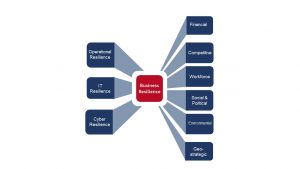
Comparing Resilience – Part One: Business Resilience
In recent years, organizations across the globe have faced a series of challenges—from regulatory upheavals and evolving trends, to evolving consumer needs and supply chain disruptions. Regardless of the event, companies need to be able to respond quickly to disruptions that critically impact their data assets and core operations.
This may require accelerating digital transformation efforts, making strategic data-driven decisions, and evolving their operational practices to align with extant possibilities. However, the best results can be obtained by strategically engineering business, operational, IT, and cyber resilience.
This five-part mini-series will cover these four types of resilience and enable you to understand and compare them. Let’s get started!
What Is Business Resilience?
Business resilience is the ability of an organization to survive and quickly recover from unplanned disruptions while protecting its reputation, assets, and people. It also denotes an organization’s ability to seamlessly adapt its operations to absorb shocks and thrive despite a continuously changing environment, whether the disruption is business, economic, social, environmental, or geo-strategic in nature.
Business resilience encompasses all aspects of an organization: its workforce, business processes, infrastructure—from IT to offices, manufacturing sites, etc., and partners involved in delivering goods and/or services.
How Do You Establish Business Resilience?
Because of all the dimensions within which a business operates, business resilience is really multi-dimensional by nature and cannot be achieved by addressing only one or only a few of these dimensions.
Operational resilience, IT resilience and cyber resilience, however, are three aspects of resilience over which an organization has much more control. These types of resilience deal with mostly unforeseen, disruptive events that live in the immediate to short-term horizon of a business.
Having a business continuity plan (along with strong disaster recovery plans) to guide your organization on when, how, and what to do to resume operations when such disruptive events strike, is a great way to begin establishing business resiliency.
Achieving true business resilience includes the management of longer-term trends and threats (as shown in the diagram below) through business strategy. This often leads to changes and the evolution of an organization’s business and operating models.
The Covid-19 pandemic is a good example to illustrate business resilience. Many organizations had to react to quick lockdowns and other related restrictions using plans related to operational and IT resilience. However, deeper organizational changes were necessary to adapt to the new reality of remote or hybrid work of the workforce. This was initially driven by the pandemic, which in turn led to profound and lasting changes in the definition of work. Resilient organizations have been able to weather both the short-term aspect of the pandemic, but also its longer-term impact on talent acquisition and retention.
The Importance of Business Resiliency
Building resilience can help businesses weather immediate disruptions such as cyberattacks and natural disasters while strategically preparing, adjusting, and adapting to longer-term trends and realities. Such preparations and contingency plans can mean the difference between business failure or survival. Only resilient businesses can adapt fast enough to sudden changes in regulatory requirements, market demands, or unexpected disruptions.
What Does a Strong, Business-Resilient Solution Include?
Information technology is becoming the cornerstone of business resilience strategies. Having the right tools and technologies can help company leaders and stakeholders seamlessly design, test, and implement business resilience plans. Such technologies employ simple recovery workflows, ensuring continuous data protection and the ability to run simulations and non-disruptively test disaster recovery plans often—all in a single, simple, and scalable solution.
Next: Operational Resilience
In part two of this mini-series, we are going to review operational resilience and get a sense of how it differs from business resilience. Stay tuned!
Until then, feel free to contact us with any questions you have about your organization’s resilience, or simply learn more about us on your own.


